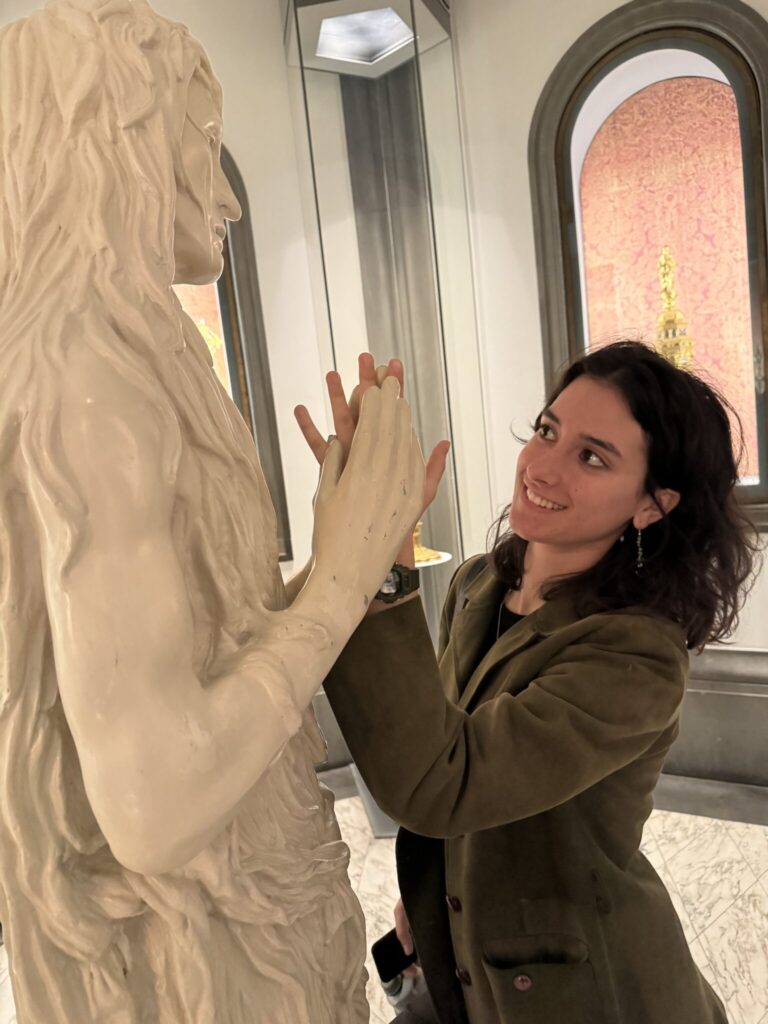by Serena Plage

Students in Prof. Nadja Aksamija’s seminar Eloquent Forms: Topics in Renaissance and Baroque Sculpture went on a 12-day, faculty-led study trip to Rome and Florence over spring break (March 9-21, 2024). Some of the highlights in Rome included the Capitoline Museums and the Roman Forum, St. Peter’s Basilica and the Vatican Museums, the Villa Borghese, and several churches housing important works of Renaissance and Baroque sculpture, including San Pietro in Vincoli (home to Michelangelo’s Tomb of Julius II) and Santa Maria della Vittoria (home to Bernini’s Ecstasy of St. Theresa). In Florence, students gave oral presentations in front of select sculptures at the Bargello and the Museo dell’Opera del Duomo, in addition to visiting the Uffizi, the Casa Buonarroti, Palazzo Pitti, Orsanmichele, and various churches. The last day was spent outside the city, at the Medici villas of Pratollino and Castello, where they saw Giambologna’s Apennine Colossus and enjoyed the Grotto of the Animals.


The trip was sponsored by Wesleyan’s Course-Embedded Experiential Learning (CEEL) Program, designed to “enhance student learning with experiential, on-site activities in countries around the world.” The Fries Center for Global Studies states that this program “broadens the range of global learning opportunities for our students, including those who might not otherwise have studied abroad.” For Ronan Buckingham ’24, “the trip to Rome and Florence was a highlight of my time at Wesleyan. It felt like a culmination of my art history education, allowing me the independence to fully engage with another culture, whether that be artistically, socially, or culinarily.”


Having spent the first half of the semester immersed in intensive reading and discussion, students were well prepared to visit Italy and to engage directly with the works of art they had seen only in slides before the trip. As Mae Wrigley ’26 describes, “the experience of studying a work in depth in the classroom and then seeing it in person is like no other. It is one thing to take in the technical prowess of a work from an image, it is another entirely to be able to take in the monumentality of the sculpture in person.” Aidan Jelveh ’24 “left the trip with a better understanding of what sorts of art historical questions really excite me.”


When asked about which works had the most impact on them in person, Aidan said: “St. Cecilia. I appreciated that she was deceased, it fit the stillness of the stone. I loved many of the reliquaries I saw. I also cannot stop thinking about the marble-camouflaged speakers at St. Peter’s.” Mae added: “In Italy, I found myself overcome with emotion when viewing pieces we had studied in class, especially those which reside in the Loggia dei Lanzi in Florence. This wonderfully overwhelming experience stuck with me, and I ultimately chose to write about them for my final research project.” Ronan wrote: “Since I had studied it for my final paper, the Florentine Pietà by Michelangelo was my favorite piece I saw abroad. When I saw it in person the roughness and physicality of the statue were very moving, especially in light of my research. Of all the churches we visited the Basilica di Santa Cecilia was the most surprising. Entering into the church’s enclosed courtyard felt like entering another world. Further, I had never seen medieval frescos or a crypt, both beautiful features of the basilica.”


Though the primary focus of the trip was Renaissance and Baroque sculpture, student learning while in Italy went far beyond class content. Ronan described how he “discovered how important art can be in shaping the landscape and space of a city. Entering into a piazza always felt special, and that was in large part due to the artwork centered around it. I also learned about the extent of my adventurousness when I walked to the Basilica di San Miniato in Florence. It was one of my favorite moments on the trip, I felt like I knew Florence better as a city because of it.” Aidan added: “As a senior, I’ve gotten very used to interacting with and living with the same few people. It was fun to get to know new people and grow as a social being.” Mae felt that “this class and its trip was an incredibly unique opportunity to connect with my peers through the study of art. This diverse group taught me so much about the world from their variety of life experiences. Through exploring a new part of the globe alongside them, I expanded my worldview in a way that would not have been possible without this class.”
This article was originally published in the ARHA Student Spotlight.


